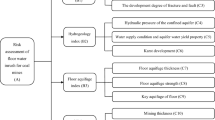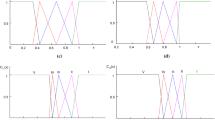Abstract
Backfill mining is an environmentally friendly and sustainable application that mitigates subsidence and prevents water inrush. A quantitative analysis method to assess the risks of water inrush and subsidence due to backfill mining was established combining a modified analytic hierarchy process (AHP) with fuzzy evaluation. The model considers three criteria and 12 factors to determine the weight of each index and criterion based on the modified AHP. Then, the fuzzy relation of the evaluation index to the risk degree was assessed. Following the fuzzy operation involving evaluation matrices, the risk degree was comprehensively evaluated based on a case study of the Lvgou Coal Mine. Mining activity was the most important factor in the risk of water inrush, followed by geological conditions. High-risk areas were transformed into low-risk areas by the use of backfill mining rather than caving mining, which effectively validated the accuracy of the evaluation model. This study also offers an effective reference source for practical engineering and for the formulation of prevention and control measures to ensure safe mining under aquifers and buildings.
Zusammenfassung
Der Versatzbergbau ist eine umweltfreundliche und nachhaltige Methode, die Setzungen abmildert und Wassereinbrüche verhindert. Es wurde eine quantitative Analysemethode zur Bewertung der Risiken von Wassereinbrüchen und Setzungen durch den Versatzbergbau entwickelt, die einen modifizierten analytischen Hierarchieprozess (AHP) mit einer Fuzzy-Bewertung kombiniert. Das Modell berücksichtigt drei Kriterien und 12 Faktoren, um die Gewichtung der einzelnen Indizes und Kriterien auf der Grundlage des modifizierten AHP zu bestimmen. Anschließend wurde die Fuzzy-Beziehung zwischen dem Bewertungsindex und dem Risikograd bewertet. Nach der Fuzzy-Operation mit Bewertungsmatrizen wurde der Risikograd anhand einer Fallstudie des Kohlebergwerks Lvgou umfassend bewertet. Die Bergbautätigkeit war der wichtigste Faktor für das Risiko eines Wassereinbruchs, gefolgt von den geologischen Bedingungen. Hochgefährdete Gebiete wurden durch den Einsatz von Versatzbergbau anstelle von Höhlenbergbau in Gebiete mit geringem Risiko umgewandelt, was die Genauigkeit des Bewertungsmodells effektiv bestätigte. Diese Studie bietet auch eine wirksame Referenzquelle für die technische Praxis und für die Formulierung von Präventions- und Kontrollmaßnahmen, um einen sicheren Bergbau unter Grundwasserleitern und Gebäuden zu gewährleisten.
Resumen
La minería de relleno es una aplicación sostenible y respetuosa con el medio ambiente que mitiga los hundimientos y evita las irrupciones de agua. Se estableció un método de análisis cuantitativo para evaluar los riesgos de irrupción de agua y hundimiento debidos a la minería de relleno combinando un proceso de jerarquía analítica (AHP) modificado con una evaluación difusa. El modelo tiene en cuenta 3 criterios y 12 factores para determinar el peso de cada índice y criterio basándose en el AHP modificado. A continuación, se evaluó la relación difusa del índice de evaluación con el grado de riesgo. Tras la operación difusa con las matrices de evaluación, se evaluó exhaustivamente el grado de riesgo a partir de un estudio de caso de la mina de carbón de Lvgou. La actividad minera fue el factor más importante en el riesgo de irrupción de agua, seguido de las condiciones geológicas. Las zonas de alto riesgo se transformaron en zonas de bajo riesgo mediante el uso de la minería de relleno en lugar de la minería de espeleología, lo que validó eficazmente la precisión del modelo de evaluación. Este estudio también ofrece una fuente de referencia eficaz para la ingeniería práctica y para la formulación de medidas de prevención y control que garanticen la seguridad de la minería bajo los acuíferos y las construcciones.
抽象的
充填开采可减小沉降和防止突水, 是一种环境友好和可持续的应用技术。利用修正的层次分析法(AHP)和模糊评价, 建立了一种定量评估充填开采引起突水和沉降风险的方法。基于修正的层次分析(AHP), 模型考虑了三个标准和12个因素, 确定了每个指标和标准的权重。然后, 评估了评价指标与风险程度的模糊关系。在评价矩阵的模糊运算之后, 以吕沟煤矿为例, 综合评价了风险程度。采矿活动是引发突水风险的最重要因, 其次是地质条件。充填开采(而不是冒落开采)将高风险区转化为低风险区, 验证了评价模型的准确性。研究还为含水层和建筑物下安全开采的工程实践和防控措施提供了有益参考。






Similar content being viewed by others
References
Arefieva O, Nazarkina AV, Gruschakova NV, Skurikhina JE, Kolycheva VB (2019) International soil and water conservation research impact of mine waters on chemical composition of soil in the Partizansk Coal Basin, Russia. Int Soil Water Conserv Res 7:57–63. https://doi.org/10.1016/j.iswcr.2019.01.001
Aznar-Sánchez JA, Velasco-Muñoz JF, Belmonte-Ureña LJ, Manzano-Agugliaro F (2019) Innovation and technology for sustainable mining activity: a worldwide research assessment. J Clean Prod 221:38–54. https://doi.org/10.1016/j.jclepro.2019.02.243
Bai E, Guo W, Tan Y, Yang D (2018) The analysis and application of granular backfill material to reduce surface subsidence in China’s northwest coal mining area. PLoS ONE 13(7):1–14. https://doi.org/10.1371/journal.pone.0201112
Chen L, Feng X, Xu D, Zeng W, Zheng Z (2018) Prediction of water inrush areas under an unconsolidated, confined aquifer: the application of multi-information superposition based on GIS and AHP in the Qidong coal mine, China. Mine Water Environ 37:786–795. https://doi.org/10.1007/s10230-018-0541-1
Diao X, Wu K, Zhou D, Wang J, Duan Z, Yu Z (2019) Combining subsidence theory and slope stability analysis method for building damage assessment in mountainous mining subsidence regions. PLoS ONE 14(2):1–18. https://doi.org/10.1371/journal.pone.0210021
Ding Y, Feng G, Wang C (2011) Experimental research on basic properties of superhigh-water packing material. J China Coal Soc 36(7):1087–1092 (in Chinese)
Du W, Jiang Y, Ma Z, Jiao Z (2017) Assessment of water inrush and factor sensitivity analysis in an amalgamated coal mine in China. Arab J Geosci 10(21):471. https://doi.org/10.1007/s12517-017-3261-0
Feng G, Sun C, Wang C, Zhou Z (2010) Research on goaf filling method with superhigh-water material. J China Coal Soc 35(12):1963–1968 (in Chinese)
Huang P, Spearing AJS, Feng J, Jessu KV, Guo S (2018) Effects of solid back filling on overburden strata movement in shallow depth longwall coal mines in west China. J Geophys Eng 15:2194–2208. https://doi.org/10.1088/1742-2140/aac62c
Isiaka AI, Durrheim RJ, Manzi MS (2019) High-resolution seismic reflection investigation of subsidence and sinkholes at an abandoned coal mine site in South Africa. Pure Appl Geophys 176(4):1531–1548. https://doi.org/10.1007/s00024-018-2026-3
Kumar S, Dutta SC, Nainegali L (2018) Constructing structures on backfilled opencast mine spoil for better sustainability. Curr Sci. https://doi.org/10.18520/cs/v114/i10/2053-2062
Li X, Du J, Gao L, He S, Gan L, Sun C, Shi Y (2017) Immobilization of phosphogypsum for cemented paste backfill and its environmental effect. J Clean Prod 156:137–146. https://doi.org/10.1016/j.jclepro.2017.04.046
Li H, Bai H, Wu J, Meng Q, Ma K, Wu L, Meng F, Wang S (2019a) A set of methods to predict water inrush from an ordovician karst aquifer: a case study from the Chengzhuang Mine, China. Mine Water Environ 38:39–48. https://doi.org/10.1007/s10230-018-00572-3
Li S, Wu J, Xu ZH, Yang WM (2019b) Mechanics criterion of water inrush from the coal floor under influence of fault and its engineering application. Int J Geomech 19(5):1–9. https://doi.org/10.1061/(ASCE)GM.1943-5622.0001387
Li Q, Meng X, Liu Y, Pang L (2019c) Risk assessment of floor water inrush using entropy weight and variation coefficient model. Geotech Geol Eng 37(3):1493–1501. https://doi.org/10.1007/s10706-018-0702-9
Lin C, Zhang M, Zhou A, Li L, Shi S et al (2020) A new quantitative method for risk assessment of water inrush in karst tunnels based on variable weight function and improved cloud model. Tunn Undergr Sp Technol 95:103136. https://doi.org/10.1016/j.tust.2019.103136
Liu J, Sui W, Zhao Q (2017) Environmentally sustainable mining: a case study of intermittent cut-and-fill mining under sand aquifers. Environ Earth Sci 76(16):562. https://doi.org/10.1007/s12665-017-6892-2
Liu J, Zhang D, Yang B, Liu S, Xu K (2020) Suitability of aquifer-protection mining in ecologically fragile areas in western China. Environ Earth Sci 79(14):356. https://doi.org/10.1007/s12665-020-09098-w
Lu H, Qi C, Chen Q, Gan D, Xue Z, Hu Y (2018) A new procedure for recycling waste tailings as cemented paste backfill to underground stopes and open pits. J Clean Prod 188:601–612. https://doi.org/10.1016/j.jclepro.2018.04.041
Ma D, Rezania M, Yu H, Bai H (2017) Variations of hydraulic properties of granular sandstones during water inrush: effect of small particle migration. Eng Geol 217:61–70. https://doi.org/10.1016/j.enggeo.2016.12.006
Morrison KG, Reynolds JK, Wright IA (2019) Subsidence fracturing of stream channel from longwall coal mining causing upwelling saline groundwater and metal-enriched contamination of surface waterway. Water Air Soil Pollut 230(2):37. https://doi.org/10.1007/s11270-019-4082-4
Qi W, Zhang J, Zhou N, Wu Z, Zhang J (2019) Mechanism by which backfill body reduces amount of energy released in deep coal mining. shock and vibration. Shock Vibr. https://doi.org/10.1155/2019/8253269
Saaty TL (1980) The analytic hierarchy process: planning, priority setting, resource allocation. McGraw-Hill, NY
Sun Q, Zhang J, Zhou N, Qi W (2018) Roadway backfill coal mining to preserve surface water in western China. Mine Water Environ 37:366–375. https://doi.org/10.1007/s10230-017-0466-0
Tekin Y, Ercikdi B, Deveci H (2018) Utilisation of construction and demolition waste as cemented paste backfill material for underground mine openings. J Environ Manag 222:250–259. https://doi.org/10.1016/j.jenvman.2018.05.075
Wu Q, Du Y, Xu H, Zhao Y et al (2020) Finding the earliest arrival path through a time-varying network for evacuation planning of mine water inrush. Saf Sci. https://doi.org/10.1016/j.ssci.2020.104836
Yan W, Chen J, Yan Y (2019) A new model for predicting surface mining subsidence: the improved lognormal function model. Geosci J 23(1):165–174. https://doi.org/10.1007/s12303-018-0008-1
Yang B (2018) Spatio-temporal variation of fractures in overburden due to mining and risk assessment model for water and sand inrushes. China Univ of Mining and Technology, Xuzhou (in Chinese)
Yang B, Sui W, Duan L (2017) Risk assessment of water inrush in an underground coal mine based on GIS and fuzzy set theory. Mine Water Environ 36:617–627. https://doi.org/10.1007/s10230-017-0457-1
Zhang J, Xie R (2019) Numerical analysis of mechanical behavior of buried pipes in subsidence area caused by underground mining. J Press Vessel Technol 141(2):1–8. https://doi.org/10.1115/1.4042711
Zhang G, Zhang K, Wang L, Wu Y (2015) Mechanism of water inrush and quicksand movement induced by a borehole and measures for prevention and remediation. Bull Eng Geol Environ 74(4):1395–1405. https://doi.org/10.1007/s10064-014-0714-5
Zhang Y, Cao S, Guo S, Wan T, Wang J (2018a) Mechanisms of the development of water-conducting fracture zone in overlying strata during shortwall block backfill mining: a case study in northwestern China. Environ Earth Sci 77(14):543. https://doi.org/10.1007/s12665-018-7726-6
Zhang Q, Du C, Zhang J et al (2018b) Backfill support’s backfill and operation properties and evaluation. J Cent South Univ 25(6):1524–1534. https://doi.org/10.1007/s11771-018-3845-1
Zhao T, Ma S, Zhang Z (2018a) Ground control monitoring in backfilled strip mining under the metropolitan district: case study. Int J Geomech 18(7):1–14. https://doi.org/10.1061/(ASCE)GM.1943-5622.0001163
Zhao T, Fu Z, Li G (2018b) In situ investigation into fracture and subsidence of overburden strata for solid backfill mining. Arab J Geosci 11(14):398. https://doi.org/10.1007/s12517-018-3769-y
Zhou D, Wu K, Bai Z et al (2019) Formation and development mechanism of ground crack caused by coal mining: effects of overlying key strata. Bull Eng Geol Environ 78(2):1025–1044. https://doi.org/10.1007/s10064-017-1108-2
Zhu W, Yu S, Xuan D, Shan Z, Xu J (2018) Experimental study on excavating strip coal pillars using caving zone backfill technology. Arab J Geosci 11(18):554. https://doi.org/10.1007/s12517-018-3914-7
Acknowledgements
The authors acknowledge the financial support received from the Science and Technology Project of Henan Province under Grant 212102310596 and Key Scientific Research Project of Colleges and Universities in Henan Province under Grant 21A410003 of Education Dept, Henan Province.
Author information
Authors and Affiliations
Corresponding author
Rights and permissions
About this article
Cite this article
Liu, J., Yang, B., Yuan, S. et al. A Fuzzy Analytical Process to Assess the Risk of Disaster when Backfill Mining Under Aquifers and Buildings. Mine Water Environ 40, 891–901 (2021). https://doi.org/10.1007/s10230-021-00822-x
Received:
Accepted:
Published:
Issue Date:
DOI: https://doi.org/10.1007/s10230-021-00822-x




